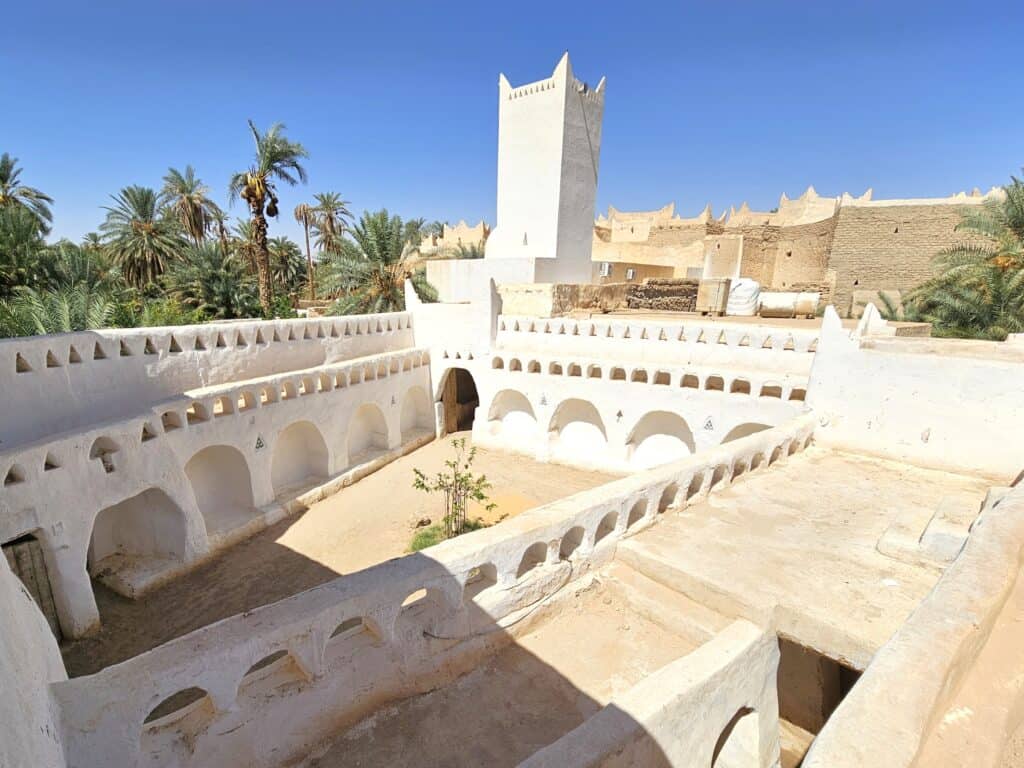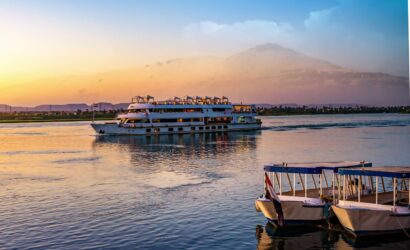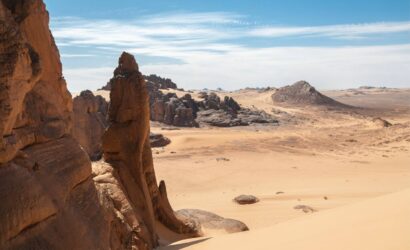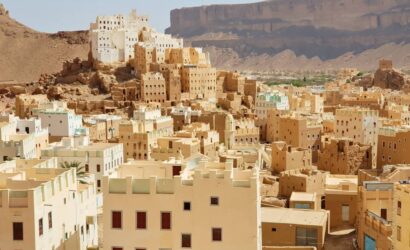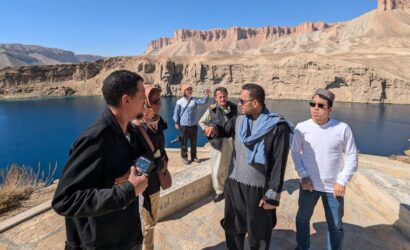Travel through time and across terrain with our 6-day Libya Grand Trip, a once-in-a-lifetime expedition that blends ancient Roman cities, Berber mountain fortresses, remote desert oases, and cultural encounters in one unforgettable itinerary. Your tour in Libya begins in Tripoli, a city where centuries collide. Walk through vibrant souks, discover Roman arches, and feel the pulse of North Africa’s underrated capital.
From there, stand in awe among the grand ruins of Leptis Magna, and drive west through the Jebel Nafusa mountains, to the Libya UNESCO site settled in the desert, the oasis city of Ghadames—a place so ancient and untouched it feels like a dream. Explore Berber troglodyte houses, climb desert forts, and enjoy a traditional Touareg fire camp under the stars. End your journey with the seaside ruins of Sabratha, before your flight home.
Itinerary:
Day 1 » 10:05 Tripoli morning arrival by Turkish Airlines » Airport Meet & Greet » 12:00 Hotel transfer » 14:00 Tripoli Old City Tour (Martyr’s Square, Arch of Marcus Aurelius, Red Castle, Bab Al-Menshia Street, Saraya Market, Gurgi Mosque, House of Yusuf Karamanli)
Day 2 » 07:30 Tripoli » 8:30 Sabratha » Jebel Nafusa (11:30 Qasr al-Hajj, 14:30 Kabaw Qasr) » 19:00 Ghadames
Day 3 » 08:30 Ghadames Old City Tour » 17:00 4WD Desert Safari (Ras Al-Ghoul Fort, Sand Dunes, Touareg Fire Camp)
Day 4 » 07:30 Ghadames » 10:30 Al Majabrah road » 14:30 Bu Gheilan (Troglodyte Houses) » 17:00 Tripoli
Day 5 » 08:00 Tripoli » Leptis Magna » 16:00 Tripoli Corniche Tour (Coastal road, Corniche, Algiers Square)
Day 6 » 09:00 Airport transfer // End of our services » 12:05 Tripoli departure by Turkish Airlines
Our tours in Libya and personalized itineraries has been thoughtfully designed around Turkish Airlines daily flights from Istanbul and Tripoli. Specifically, we have aligned our schedule with the flight arriving at Mitiga International Airport (MJI) at 10:05 AM, ensuring a comfortable morning start to the tour activities upon your arrival. On the departure day, our tour conveniently concludes in time for the Turkish Airlines flight departing from Tripoli at 12:05 PM, allowing travelers a relaxed morning transfer from the hotel to the airport.
Interested in exploring available flight options to Tripoli? Click the boxes below to view more details.
🛫 Recommended Morning Arrivals to Tripoli (MJI) (Day 1)
Your morning arrival in Tripoli can be arranged with airlines such as Turkish Airlines, Libyan Wings, Afriqiyah Airways, EgyptAir, and ITA Airways. If your flight timing is different, please inform us so we can assist with logistics. Remember, the Tripoli Old City Tour begins at 14:00.
| Origin City | Airline | Flight No. | Departure Airport | Arrival Tripoli | Arrival Time |
|---|---|---|---|---|---|
| 🇹🇷 Istanbul | Turkish Airlines | TK639 | Istanbul (IST) | Mitiga (MJI) | 10:30 AM |
| 🇹🇷 Istanbul | Libyan Wings | YL101 | Istanbul (IST) | Mitiga (MJI) | 06:00 AM |
| 🇪🇬 Cairo | EgyptAir | MS831 | Cairo (CAI) | Mitiga (MJI) | 09:40 AM |
| 🇹🇳 Tunis | Afriqiyah Airways | 8U451 | Tunis–Carthage (TUN) | Mitiga (MJI) | 11:15 AM |
| 🇹🇳 Tunis | Libyan Wings | YL801 | Tunis–Carthage (TUN) | Mitiga (MJI) | 11:30 AM |
| 🇮🇹 Rome | ITA Airways | AZ868 | Rome–Fiumicino (FCO) | Mitiga (MJI) | 12:10 PM |
This table is illustrative and approximate. Flight schedules can and will change without prior notice, so it serves only as a general guideline for planning purposes. Always confirm your flights directly with the airline.
🛫 Recommended Morning Departures from Tripoli (MJI) (Day 6)
Your morning departure from Tripoli can be arranged with airlines such as Turkish Airlines, Libyan Wings, Afriqiyah Airways, EgyptAir, and MedSky Airways. Should your flight differ, please inform us to help coordinate logistics. Remember, hotel check-out time is at 12:00.
| Destination City | Airline | Flight No. | Departure Tripoli | Arrival Airport | Arrival Time |
|---|---|---|---|---|---|
| 🇹🇷 Istanbul | Turkish Airlines | TK641 | 12:05 PM | Istanbul Airport (IST) | 04:20 PM |
| 🇹🇷 Istanbul | Libyan Wings | YL100 | 07:00 AM | Istanbul Airport (IST) | 10:15 AM |
| 🇮🇹 Rome | MedSky Airways | BM0522 | 08:50 AM | Rome–Fiumicino Airport (FCO) | 09:50 AM |
| 🇹🇳 Tunis | Libyan Wings | YL800 | 07:55 AM | Tunis–Carthage Airport (TUN) | 09:05 AM |
| 🇹🇳 Tunis | Afriqiyah Airways | 8U450 | 10:30 AM | Tunis–Carthage Airport (TUN) | 11:40 AM |
| 🇪🇬 Cairo | EgyptAir | MS832 | 10:40 AM | Cairo International (CAI) | 01:25 PM |
This table is illustrative and approximate. Flight schedules can and will change without prior notice, so it serves only as a general guideline for planning purposes. Always confirm your flights directly with the airline.
-
Tripoli
-
Tripoli
-
4★ hotels with breakfast
-
Included
-
Private sedan, SUV, or van with air conditioning
-
Airport meet & greet with assistance through formalities
-
Tripoli, Qasr al-Hajj, Kabaw Qasr, Bu Gheilan, Ghadames, Leptis Magna, Sabratha
-
LOI and visa included — full service for fast e-Visa in 10 days.
Itinerary
Arrival at Tripoli International Airport is scheduled for 10:05 via Turkish Airlines. After passport procedures and a meet and greet, you’ll transfer to your hotel around noon for check-in and rest. At 14:00, the introductory city tour begins in the historic center.
Starting at Martyr’s Square, you’ll proceed to the Arch of Marcus Aurelius, one of the few visible Roman remains in the city, built in 165 CE during the reign of Emperor Marcus Aurelius. From there, you’ll walk to the exterior of the Red Castle (Assaraya al-Hamra), with foundations dating back to the 16th-century Spanish occupation and later Ottoman expansions. Strolling through Bab Al-Menshia Street, you’ll explore Saraya Market and nearby lanes leading to the Gurgi Mosque, a uniquely ornate Ottoman mosque built in 1834. The day ends with a visit to the House of Yusuf Karamanli, home of the former ruling family.
This visit helps you see how history, religion, and daily life connect here.
Travel Distance & Time:
Approx. 35 km – 45 minutes (airport to hotel + local transfers)
Historical Context:
- Arch of Marcus Aurelius: Constructed under Roman Tripoli around 165 CE
- Red Castle: Built over centuries; current structure reflects Spanish and Ottoman design
- Gurgi Mosque: Commissioned in 1834 by Mustafa Gurgi during the late Ottoman period
Curiosities & Local Facts:
- The Red Castle was used by Italian authorities during colonial rule as a military base
- Gurgi Mosque’s marble columns were repurposed from earlier Roman sites nearby
5 Key Highlights:
- Walk through Martyr’s Square
- Visit to the Arch of Marcus Aurelius
- External view of the Red Castle
- Gurgi Mosque interior visit
- Insight into the Karamanli residence
Important for you today
- Ottoman Tripoli
- Karamanli dynasty
- Roman arch Tripoli
The day begins early with departure from Tripoli at 07:30. After a one-hour drive, you’ll reach the Roman city of Sabratha by 08:30. After exploring this seaside archaeological site, you’ll continue inland toward the Jebel Nafusa region.
At Sabratha, you’ll explore the impressive 2nd-century CE Roman theater, its well-preserved stage and three-story backdrop among the most striking in North Africa. The site also includes Punic-era foundations, early Christian basilicas, and a forum area. Around 11:30, you’ll arrive at Qasr al-Hajj, a circular fortified granary used by Berber communities. Then, at 14:30, visit Kabaw Qasr, another multi-story stone granary with internal storage cells still intact. By 19:00, you’ll reach the oasis town of Ghadames and check in at your local accommodation.
This stop gives context to how ancient trade shaped the region and sustained desert communities.
Travel Distance & Time:
Approx. 610 km – 9 hours total (with stops)
Historical Context:
- Sabratha: Founded by the Phoenicians in the 6th century BCE; Romanized in 1st century CE
- Qasr al-Hajj: Likely constructed in the 12th–13th centuries for communal grain storage
- Kabaw: Used as a fortified storehouse and seasonal settlement point
Curiosities & Local Facts:
- Sabratha’s basilicas show early Christian use during the 4th century
- Berber granaries were often managed by local tribes or families to control food distribution
5 Key Highlights:
- Roman theater of Sabratha
- Early Christian basilicas
- Visit to Qasr al-Hajj granary
- Exploration of Kabaw stone storehouse
- Scenic arrival into Ghadames oasis
Important for you today:
- Roman ruins Sabratha
- Berber granaries
- Jebel Nafusa Libya
Your day begins at 08:30 with a guided tour of Ghadames, a UNESCO-listed old city. The morning includes walking through its covered alleyways, unique multi-story homes, and rooftop passages. Lunch is arranged locally.
The Old City of Ghadames features a labyrinth of passages designed for protection from the sun and tribal conflicts. Homes are built from mud, palm wood, and gypsum, with communal water channels and shared courtyards. In the afternoon, the group transitions to 4WD vehicles and heads into the surrounding desert. The tour includes Ras Al-Ghoul Fort, believed to be a watchtower site on ancient caravan routes, followed by a visit to nearby dunes for sunset views. The day ends at a desert Touareg-style fire camp.
You’ll walk through places that still carry the marks of past empires and desert traditions.
Travel Distance & Time:
Approx. 60 km – 2 hours (local + off-road)
Historical Context:
- Ghadames: Settled since Roman times; called “Cydamus” in antiquity
- Ras Al-Ghoul Fort: Used historically to monitor caravan trade routes into Algeria and Tunisia
Curiosities & Local Facts:
- Ghadames homes often had separate entrances for men and women
- Traditional Ghadames architecture uses white gypsum to reflect sunlight and cool interiors
5 Key Highlights:
- Walk through Ghadames old city
- Rooftop corridors and hidden alleys
- Ras Al-Ghoul desert fort
- Sunset in the Saharan dunes
- Night at traditional fire camp
Import for you today:
Touareg desert camp
Ghadames architecture
Saharan caravan routes
Departing Ghadames at 07:30, you’ll head northeast through remote desert roads. By 10:30, you’ll drive along the Al Majabrah route, a sparsely populated plateau cutting across western Libya. Around 14:30, you’ll arrive in Bu Gheilan, a lesser-known site home to troglodyte dwellings carved into sandstone hills.
The cave houses of Bu Gheilan were used by Berber communities and designed for thermal insulation and security. Many still show smoke-blackened ceilings and stone-carved niches. After exploring the site and a short break, you’ll return to Tripoli by 17:00 and check back into your hotel.
This journey helps illustrate how geography and environment shaped rural life in Libya.
Travel Distance & Time:
Approx. 580 km – 9 hours (remote road conditions)
Historical Context:
- Bu Gheilan dwellings date back several centuries and were used into the 20th century
- Region was traditionally part of trans-Saharan nomadic networks
Curiosities & Local Facts:
- Troglodyte homes stay around 20°C year-round regardless of outside temperatures
- Local Berber families sometimes use the caves for seasonal storage today
5 Key Highlights:
- Scenic Al Majabrah desert road
- Exploration of troglodyte dwellings
- Insight into Berber survival techniques
- Return to coastal Tripoli
- Overnight rest after desert crossing
Important for you today:
Al Majabrah plateau
Troglodyte Libya
Berber cave homes
Depart Tripoli at 08:00 and drive 130 km east along the Mediterranean coast to Leptis Magna, arriving mid-morning. After an extended guided visit, return to Tripoli by 16:00 for a short coastal tour of the Corniche area.
Leptis Magna, originally founded by the Phoenicians, flourished under Roman Emperor Septimius Severus (193–211 CE), who was born here. The site includes the grand Severan Basilica, a large amphitheater by the sea, Hadrian’s Baths, and a monumental arch dedicated to the emperor. Returning to Tripoli, you’ll explore the seafront Corniche, Algiers Square, and the Italianate buildings from the colonial era.
This visit shows how Roman urbanism reached its peak in North Africa.
Travel Distance & Time:
Approx. 260 km – 4.5 hours round trip
Historical Context:
- Leptis Magna: Roman expansion from 1st century BCE; Severan building boom in early 3rd century CE
- Amphitheater: Built c. 56 CE and seats 16,000
- Severan Forum and Arch: Constructed c. 203 CE
Curiosities & Local Facts:
- Septimius Severus is the only Roman emperor born in Africa
- Leptis Magna’s harbor was once one of the largest in the Roman Empire
5 Key Highlights:
- Visit to Leptis Magna ruins
- Grand Roman basilica and amphitheater
- Return drive along coastal highway
- Walk along Tripoli Corniche
- View of Algiers Square’s colonial architecture
Important for you today:
Tripoli Corniche
Leptis Magna ruins
Roman Libya
After breakfast, transfer to Tripoli International Airport at 09:00 for your scheduled departure with Turkish Airlines at 12:05. There are no visits scheduled today.
Travel Distance & Time:
Approx. 30 km – 40 minutes (hotel to airport)
5 Key Highlights:
- Final morning in Tripoli
- Organized airport transfer
- Flight check-in assistance
- Departure by Turkish Airlines
- End of RJ Travel services
Important for you today:
Turkish Airlines Tripoli
Tripoli departure
Libya airport transfer

